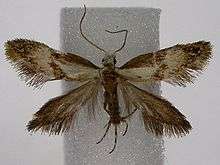Mnesarchaea
Mnesarchaeoidea is a superfamily of "New Zealand primitive moths" containing one family, Mnesarchaeidae and a single genus, Mnesarchaea, endemic to New Zealand.
| Mnesarchaea | |
|---|---|
 | |
| Scientific classification | |
| Kingdom: | Animalia |
| Phylum: | Arthropoda |
| Class: | Insecta |
| Order: | Lepidoptera |
| Clade: | Neolepidoptera |
| Infraorder: | Exoporia |
| Superfamily: | Mnesarchaeoidea |
| Family: | Mnesarchaeidae |
| Genus: | Mnesarchaea Meyrick, 1885[1] |
| Species | |
|
See text | |
| Diversity[2] | |
| 7 described species | |
Etymology
Taxonomy and systematics
Mnesarchaeoidea constitutes the living sister taxon to the superfamily Hepialoidea.[3]Within the family, there are two distinct genera, Mnesarchaea and Mnesarchella. The two are separated by differences in morphology and color. Mnesarchaea are white on the head and thorax scales while Mnesarchella have brown heads and thorax scales. There are currently 14 known species belonging to this family, four belonging to the Mnesarchaea genus and 10 to Mnesarchella.
Distribution and Development
The species within Mnesarchaea are all endemic species, occurring naturally only in New Zealand. Even within this single country, different species only occur in certain areas within New Zealand, no known species occur throughout the entire country. They live on a 1 year cycle, living as larvae and then reaching full maturity in the spring.
Morphology and Identification
The mouthparts of the adult moths are functional, unlike Hepialoidea. About seven species are not yet described, and the group is under revision by Gibbs et al. (see also Gibbs, 1979; Dugdale, 1988). Their notable traits are their small wingspan of less than 12mm and their brown bodies. The family has numerous unique physical traits including "wing venation with a single Rs1+2 vein; the lack of any positive wing-coupling mechanism; bilobed sternum A1 with external arms; male genitalia in which pseudoteguminal and valve plates are fused anteriorly to enclose a spacious subgenital crypt; female genitalia with unique elongate dorsal and subgenital plates, synscleritous anteriorly." [4]The members of this family share certain traits with other members of the Lepidoptera order such as "discrete mandibles that lack articulation or musculature; a short, coiled, functional proboscis with intrinsic muscle fibres; a primitively 3-segmented maxillary palp; functional salivary glands (as in Lophocoronidae)." [4]
Biology and behavior
The moths are mostly day-flying. The larvae live in silken galleries among liverworts and soil detritus. See Kristensen (1999: 57-59) for more details. They tend to be active from mid Spring to early Autumn in New Zealand (October to March). Throughout the day, they are most active during daylight hours, minus times when the sun is most intense. A noticeable difference between male and females is that males are the only ones that fly to travel. Females generally lay about 32 eggs in their lifetime. Larva of the family make silk-tunnels under foliage until they reach maturity, obtaining food from the tunnel.
Species
- Mnesarchaea acuta Philpott, 1929
- Mnesarchaea fallax Philpott, 1927
- Mnesarchaea fusca Philpott, 1922
- Mnesarchaea fusilella Walker, 1864 (originally in Tinea)
- Mnesarchaea loxoscia Meyrick, 1888
- Mnesarchaea hamadelpha Meyrick, 1888
- Mnesarchaea paracosma Meyrick, 1885[5]
History
Before the family was established, early collectors such as G.V. Hudson believed that individuals belonged to other families. An example is the Mnesarchaea fusiella which originally was thought to be in the Tinea family. This error was later corrected in the 1900s.
References
- Meyrick, E. 1885: Descriptions of New Zealand microlepidoptera. Gelechiadae VIII. Tineina (part). New Zealand journal of science (Dunedin), 2(12): 589-592. BHL [Original reference for ' Mnesarchaea n.g. ']
- Animal biodiversity: An outline of higher-level classification and survey of taxonomic richness - Lepidoptera
- "Neolepidoptera". www.tolweb.org. Tree of Life Web Project. Retrieved 17 October 2016.
- Gibbs, George. Mnesarchaeidae (Insecta: Lepidoptera: Hepialoidea).
- Meyrick, E. 1885: Descriptions of New Zealand microlepidoptera. Gelechiadae VIII. Tineina (part). New Zealand journal of science (Dunedin), 2(12): 589-592. BHL [Original reference for ' M[nesarchaea]. paracosma n.sp. ']
| Wikispecies has information related to Mnesarchaea |
| Wikimedia Commons has media related to Mnesarchaea. |
- Dugdale, J.S. (1988). Lepidoptera - annotated catalogue, and keys to family-group taxa. Fauna of New Zealand, 14: 1-262.
- Gibbs, G.W. (1979). Some notes on the biology and status of the Mnesarchaeidae (Lepidoptera). New Zealand Journal of Entomology, 7: 2-9.
- Kristensen, N.P. (1999) [1998]. The homoneurous Glossata. Ch. 5, pp. 51–64 in Kristensen, N.P. (Ed.). Lepidoptera, Moths and Butterflies. Volume 1: Evolution, Systematics, and Biogeography. Handbuch der Zoologie. Eine Naturgeschichte der Stämme des Tierreiches / Handbook of Zoology. A Natural History of the phyla of the Animal Kingdom. Band / Volume IV Arthropoda: Insecta Teilband / Part 35: 491 pp. Walter de Gruyter, Berlin, New York.
- Nielsen, E.S., Robinson, G.S. and Wagner, D.L. 2000. Ghost-moths of the world: a global inventory and bibliography of the Exoporia (Mnesarchaeoidea and Hepialoidea) (Lepidoptera) Journal of Natural History, 34(6):